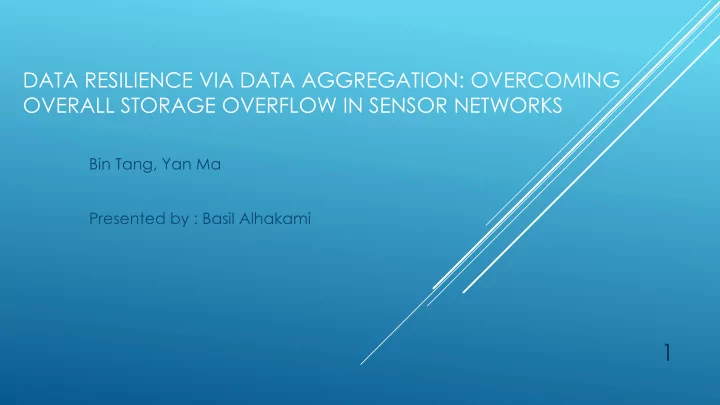

DATA RESILIENCE VIA DATA AGGREGATION: OVERCOMING OVERALL STORAGE OVERFLOW IN SENSOR NETWORKS Bin Tang, Yan Ma Presented by : Basil Alhakami 1
CONTENT Introduction Data overflow Data aggregation Formulation of Data Resilience via Data Aggregation (DRA) Multiple Traveling Salesman Walk Problem (MTSW) Solving DRA 2
INTRODUCTION Large amount of data Limited storage capacity Not feasible to install base station due to the challenging environment sensors are deployed in 3
DATA OVERFLOW Data node : nodes with overflow data Storage nodes: nodes with available storage Node storage overflow Overall storage overflow 4
DATA AGGREGATION Initiator : Send the overflow data to other nodes Aggregator: receives the overflow data and aggregates its own overflow data 5
FORMULATION OF DRA q : the number of aggregators needed |V| deployed sensor nodes m: the available storage space p: the number of data nodes R: the overflow data size at each data node before aggregation r: the overflow data size at each aggregator after aggregation At most (p-q) can be selected as initiators The number of aggregation walks cannot exceed the number of initiators 6
EXAMPLE Sensor network of 9 nodes: Data Nodes: B D E G I Storage Nodes: A C F H R = m = 1 r= ¾ Energy consumption along any edge = 1 q=4 which means we have one initiator Optimal Solution: B is the initiator The walk is: B E D G H I 7 Cost : 5
OBJECTIVE OF MTSW solving DRA in a sensor network is equivalent to solving MTSW in an aggregation graph transformed from sensor network. Given an undirected weighted graph G = (V;E) with |V |nodes and |E| edges a cost metric (which represents the distance or traveling time between two nodes) MTSW determine a subset of at most b starting nodes (i.e., the initiator in DRA) salesman can be dispatched to visit a number of other nodes following a walk, such that a) all together q nodes (excluding starting nodes) are visited b) the total cost of the walks is minimized 8
MTSW DECIDE Set of starting nodes Walking cost is minimized Such that Set of walks 9
ALGORITHMIC SOLUTION OF MTSW ( SOLVING DRA) Approximation Algorithm B walk Heuristic algorithm LP walk We need better energy consumption ( lower walk cost) 10
11
THE APPROXIMATION ALGORITHM yields a total cost of the walks that is at most (2 -1/q)times of the optimal cost. 1-sorts all the edges in E into nondecreasing order of their weights 2- initializes the set Eq to the empty set and creates |V |trees, each containing one node 3-checks each edge, if it is cycleless w.r.t. Eq. If yes, add it into Eq 4- repeat 3 until we have q edges It then obtains: all the connected components induced by these q edges. If linear topology : start from one end visits the nodes in the linear topology exactly once If it is a tree : B walk along the tree 12
HEURISTIC ALGORITHM Improve the performance of the approximation algorithm by using LP walk instead of the B walk 13
COMPARISON 14
THANK YOU 15
Recommend
More recommend